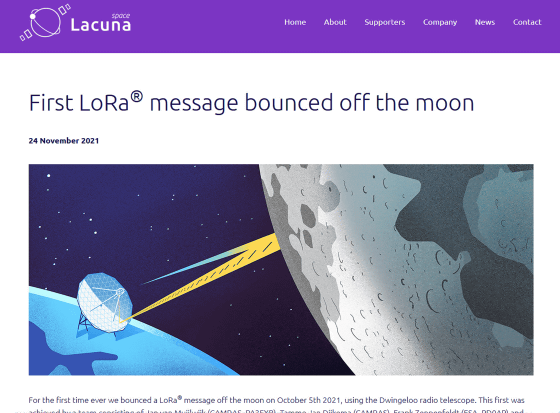Successful use of wireless communication standard 'LoRa' for long-distance communication that bounces radio waves from the earth on the moon and transmits them

First LoRa® message bounced off the moon – Lacuna
https://lacuna.space/lora-moon-bounce/

European scientists bounce first-ever LoRa message off the Moon
https://www.capacitymedia.com/articles/3830209/european-scientists-bounce-first-ever-lora-message-off-the-moon
Scientists bounce long-range message off the moon for first time
https://www.siliconrepublic.com/innovation/lora-message-moon-earth-iot
Bouncing a LoRa message off the Moon | Electronics360
https://electronics360.globalspec.com/article/17494/bouncing-a-lora-message-off-the-moon
LoRa is a wireless communication standard established by communication supplier Semtech , and because it communicates by spreading the communication signal over a wide band by spread spectrum, it is characterized by being able to communicate even with weak radio waves that are difficult to communicate with other communication methods. is. The standard name LoRa is derived from 'Long Range', and in the past, there have been reports of successful communications over distances of over 700 km.
The world's longest communication distance record by 'LoRa', which receives radio waves directly from a place more than 700 km away, is set twice a day --GIGAZINE

New research teams such as the British space communications startup Lacuna Space , the European Space Agency (ESA) , and the CA Muller Radio Astronomy Station (CAMRAS) have announced that they will use LoRa to send messages from Earth to space. I made it bounce off the surface of the moon and receive it on the earth. '
In this experiment, a signal amplified to 350 watts by a Semtech LR1110 RF transceiver chip was transmitted using the Dutch Dubbinglow 25m radio telescope operated by CAMRAS. The research team says that the signal transmitted from the earth bounces off the surface of the moon and succeeds in receiving it on the same chip after 2.44 seconds.
The Dubinglow 25m radio telescope is often used in amateur radio experiments, and it is said that experiments that bounce the signal on the surface of the moon are often conducted, but this is the first time that the LoRa signal has been bounced on the moon. .. In this experiment, the LoRa signal traveled an amazing distance of 730,360 km, setting a new record for LoRa communication distance. It was also possible to calculate the distance from the earth to the moon from the round-trip time of the signal of 2.44 seconds and the frequency shift caused by the Doppler effect due to the relative movement of the earth and the moon. This value seems to match the predicted value obtained using the JPL Horizons On-Line Ephemeris System provided by NASA very well.
The message sent in this experiment was the character string 'PI9CAM', which is the call sign of the Dubinglow 25m radio telescope.

LoRa co-inventor Nicolas Sornin said, 'This is a great experiment. I never dreamed that the day when LoRa's message would go to the moon and come back. I captured the data. I am impressed with the quality of this dataset, which will be a classic for wireless communication and signal processing students. We congratulate the research team and the CAMRAS Foundation for making this experiment possible. '
Lacuna Space CEO Thomas Telkamp commented that it was 'exhilarating' for the message to bounce back on the moon. If IoT technology is scaled up in the future, long-distance communication between the moon and the earth may be established.
Related Posts:
in Science, Posted by log1h_ik






